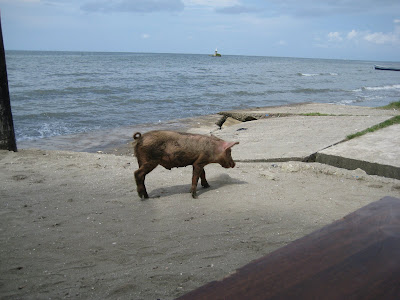 These have been five of the best months of my life, and it will be difficult for me to readjust to my life in the States. In many ways the quality of my life is better in Santiago, although it's not perfect.
These have been five of the best months of my life, and it will be difficult for me to readjust to my life in the States. In many ways the quality of my life is better in Santiago, although it's not perfect.The best things about my time here include the natural beauty of the area, the ease with which I've made friends, the simplicity of life and the gentle weather. I've missed some foods, friends and family, and organization. I've missed taking for granted the follow-through to a commitment, such as when two people agree to meet at a certain place and time.
And I've had a lot of free time here, to choose what I want to do with my day. I've had almost no chance to see TV or movies; the lake can be a distraction, but for the most part, I've stayed pretty busy with what I came here to do.
Guatemala is a poor country. The incidence of parasites is high. Malnutrition and undernutrition are everywhere, and are expected to be sharply worse in the year to come -- draught caused a poor corn harvest this year. But the real problems are cultural. Desperately poor people buy sodapop and chips to supplement their tortilla-heavy diets instead of the beans and vegetables that are relatively abundant. Parents believe refined sugar is an important part of the diet. Dental care is awful and small children routinely walk around with lollipops rolling over their teeth. Education is very poor and unvenly distributed. Some schools have much less to offer than others. Some public schools charged money to attend primary school until this year when that was made illegal. As a result our goddaughter started first grade at age ten along with dozens of other 7-13 year-olds from Panabaj and Chukmuk. Even at schools that didn't charge, education is often not valued nor seen as an escape to poverty.
In the poorer regions, women start having children around age 15, which truly exacerbates poverty, especially given the growing rate of paternal abandonment. Irma's sister and her two children have moved back home with Mom. I doubt the 19 year-old mother, uneducated and with no trade skills (the family is too desperately poor to have fostered skills such as weaving and embroidering) would be able to contribute anything toward food and firewood.
Education is the key to escaping absolute poverty. One of Irma's neighbors finished middle school a few years back, went to a six month nursing program, started working at the Hospitalito, and is now, at age 19, finishing high school, a feat not accomplished by many in the poor areas around Atitlan. She earns the minimum wage allowed by law, about $180 per month, and works long and hard hours, so much so that it may be impossible for her to continue her studies at the university level. But $180 per month is a fortune for many of the families of Chukmuk. Corn costs $20 per hundred pounds, or roughly $60 per month for a typical family; firewood costs another $10-15 per month; other foods may add $5 or much more, depending on what the family eats. With one family member earning minimum wage, the family may be able to seek occasional medical care, use the internet, buy clothing, further their education.
I came to Guatemala to enjoy, to learn and to help. I think I've succeeded. There's so much more to learn, and always will be, but that's the first step in helping others; understanding their motivations and needs.
The better I get to know the community and the individuals that comprise it, the more need I see, and I believe I'll be back. Next mission: more computer labs in the schools and teacher education on how to incorporate technology into primary and early secondary education. And more time with Irma and our friends.







































